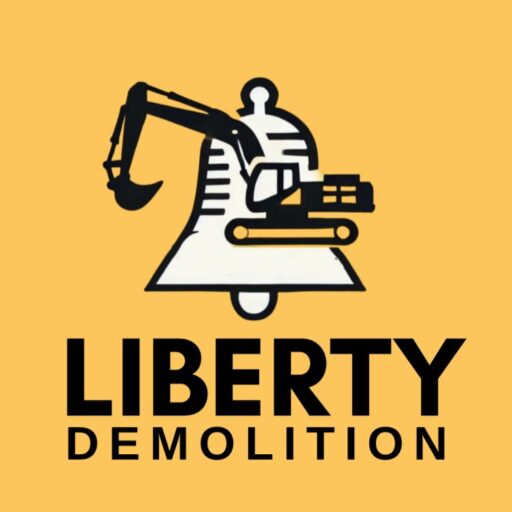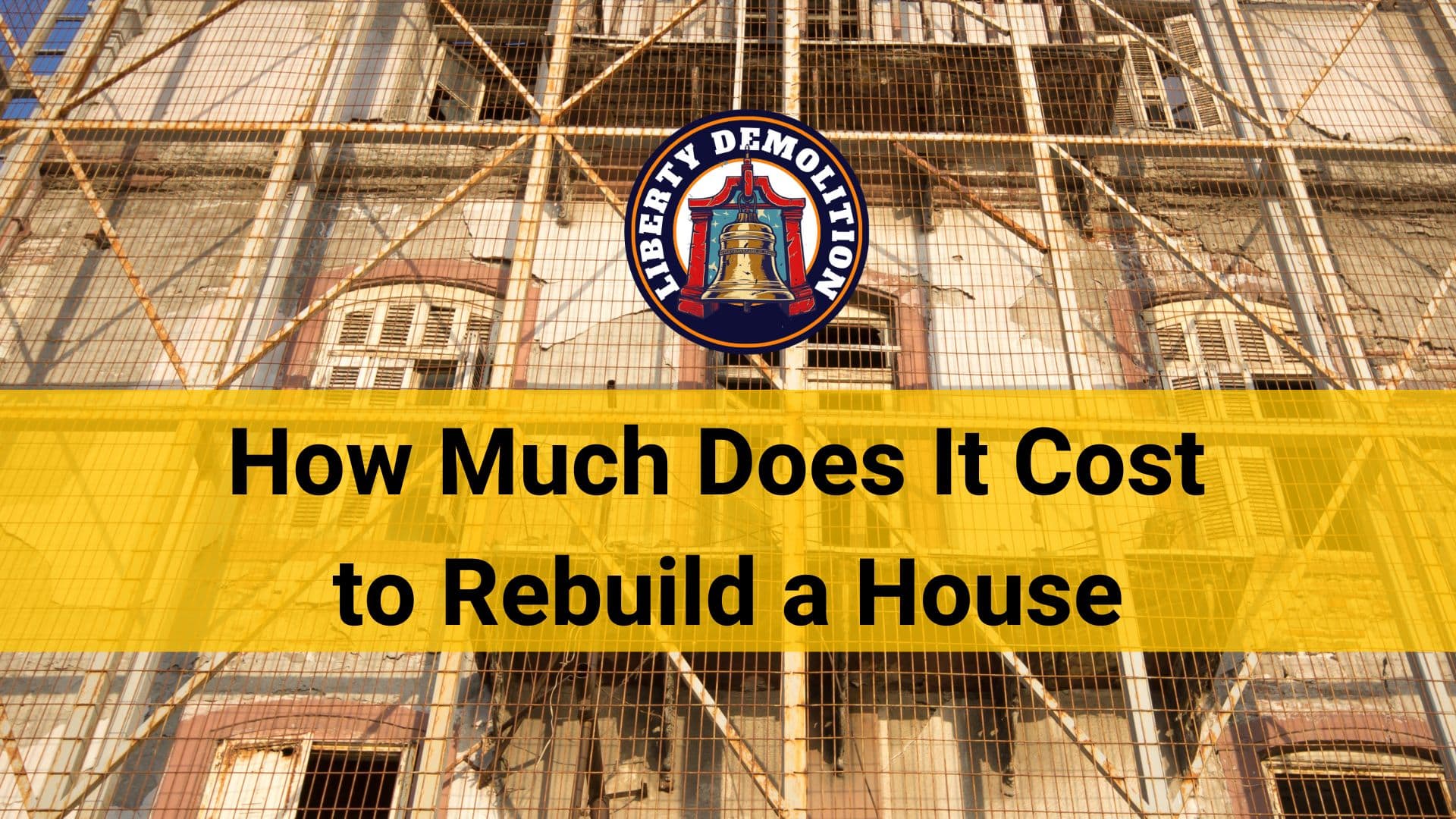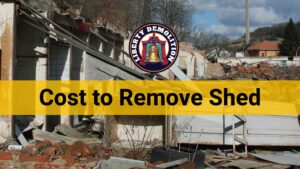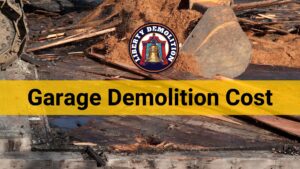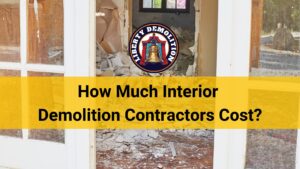On average, it ranges from $90-$150 per square foot in the US. Therefore, a 2,500-square-foot house might cost approximately $375,000 to rebuild. However, a home’s market value may differ from its rebuild cost.
Curious to learn more about how much does it cost to rebuild a house? Keep reading to find out how these costs are determined.
Calculating Demolition and Rebuild Costs
Rebuilding a home involves two significant phases: the demolition of the existing structure and the construction of the new one. While most homeowners focus on construction costs, the expenses associated with demolition are equally crucial and can significantly influence the total budget.
Average Cost to Build a Home in the USA
On a broad scale, the average cost to construct a home in the USA ranges from $90 to $150 per square foot. This translates to approximately $375,000 for a standard 2,500-square-foot home. However, these figures are general estimates and can vary based on several influencing factors:
Regional Variations
Just as real estate prices fluctuate from one location to another, so do construction costs. Building a home in urban centers with high demand for labor and materials might be more expensive than in rural or suburban areas.
Design and Layout
The complexity of the home’s design can impact the cost. A simple, single-story rectangular layout will typically be more affordable than a multi-story home with intricate design elements.
Material Choices
The selection of building materials significantly affects the overall cost. Standard materials like vinyl siding or asphalt shingles will be more budget-friendly compared to premium options like brick exteriors or slate roofs.
Labor Rates
Labor constitutes a substantial portion of construction expenses. Areas with a shortage of skilled labor or higher living costs can lead to elevated labor rates.

Importance of Consulting Local Experts for Precise Estimates
While broad statistics and online calculators offer generalized figures, they often can’t account for the unique attributes and challenges of your specific property. This is where local experts come into the picture. Here’s why consulting with them is invaluable:
Deep Knowledge of Regional Trends and Costs
Local professionals are in sync with the current trends, material prices, labor rates, and other costs specific to the area. Their insights can provide a more accurate representation of what homeowners can expect to spend, factoring in regional nuances.
Experience with Local Regulations and Permits
Every municipality has its zoning laws, building codes, and permit requirements. Local experts, having navigated these processes multiple times, can guide homeowners about potential costs, timelines, and potential regulatory hurdles.
Tailored Recommendations
Local experts can provide recommendations based on the specific conditions and challenges of the property. Whether it’s the soil type, local climate considerations, or architectural styles, their tailored advice can lead to better decision-making.
Access to a Network of Trusted Vendors and Contractors
With years of operation in the locality, these professionals have built relationships with a network of suppliers and contractors. This can translate to potential discounts, trusted workmanship, and smoother coordination throughout the project.
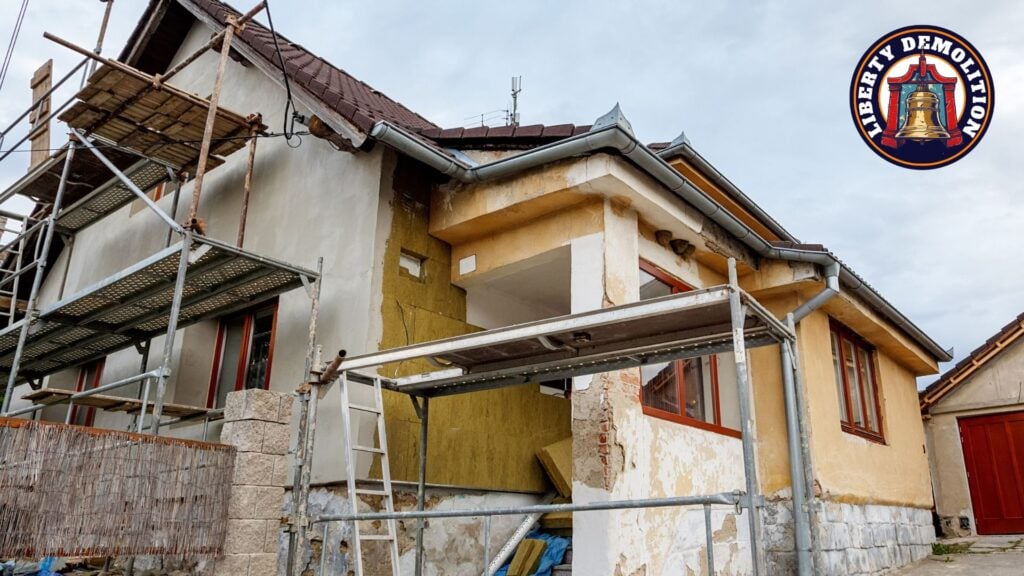
First-hand Experience with Similar Projects
Having worked on comparable projects in the vicinity, local experts can provide real-world examples, share feedback, and even arrange site visits. This helps homeowners set realistic expectations and gain a clearer picture of the end result.
Personalized Cost-Benefit Analysis
Every home rebuild involves multiple decisions, from material selection to design choices. Local experts can offer a cost-benefit analysis based on their experience, helping homeowners maximize their investment and achieve the desired outcome within the set budget.
Risk Mitigation
An experienced local professional can anticipate potential challenges, whether it’s the likelihood of hidden costs, weather-related delays, or issues stemming from the property’s location. Their expertise can help mitigate these risks and prevent cost overruns.

How Much Does It Cost to Rebuild a House: Rebuild Costs and Homeowner’s Insurance
Homeowner’s insurance is designed to protect you financially in the event of unexpected damage or loss to your home. Central to this protection is the rebuild cost, which plays an important role in determining how much coverage you should have.
Ensuring that this figure is as accurate as possible is crucial for various reasons:
Adequate Coverage for Full Rebuild
If the worst were to happen, such as a complete loss of your home due to a fire or natural disaster, an accurate rebuild cost ensures that your insurance payout would cover the full cost of rebuilding. Without it, you might find yourself significantly out-of-pocket.
Avoiding Over-insurance
While it may seem appealing to have more coverage, overestimating your rebuild cost can result in higher premiums than necessary. In the long run, you could end up paying for protection that you don’t need.
Avoiding Under-insurance
On the other hand, underestimating your rebuild cost can lead to under-insurance. This means that in the event of a claim, you’ll only receive a fraction of what’s required to restore your home, which results in potential financial hardship.
Keeping Pace with Market Changes
Material and labor costs fluctuate over time, and what was an accurate rebuild cost a few years ago might not be relevant today. Regularly reassessing this figure ensures that you remain adequately insured despite market shifts.
Accounting for Home Improvements
If you’ve made significant upgrades or renovations to your home, these will likely increase the rebuild cost. Ensuring that your insurance reflects this is crucial to avoid any coverage gaps.
Support in Policy Comparisons
When shopping around for homeowner’s insurance, having an accurate rebuild cost figure allows you to make like-for-like comparisons between different policies.
Facilitating Mortgage Approvals
Lenders often require proof of adequate homeowner’s insurance before approving a mortgage. An accurate rebuild cost can expedite this process by demonstrating that their investment (and yours) is suitably protected.
Deciding on the ideal homeowner’s insurance coverage is more than just plugging numbers into a formula. It’s about understanding your home, your financial situation, and the many risks associated with homeownership.
Typical Costs Breakdown
It’s important that you understand not only the costs of the final rebuild but also where should you allocate the money during the process. Here’s a breakdown of some important cost areas to consider when rebuilding a house:
Demolition and Site Preparation
The key factors that affect demolition cost include the size of the property, accessibility, material disposal, and any hazardous material abatement (like asbestos). Site preparation involves tasks like grading the land, ensuring proper drainage, and setting up essential utilities. Costs here can be influenced by the terrain’s nature, any existing structures like trees or boulders that need removal, and local municipal requirements.
Foundation and Structure
Once the site is cleared and prepped, laying the foundation is next. The foundation provides stability and protection against environmental factors. The choice between slab, crawl space, and basement foundations, along with regional soil conditions and labor rates, can significantly impact costs.
The structural components include concrete, steel, bricks, or other materials that form the skeletal structure. Homeowners can expect differences in costs depending on design choices, material quality, and regional expenses.
Framing and Roofing
These components form the house’s primary visual and functional elements. Framing is the ‘skeleton’ of the house, giving it shape and providing support for walls, ceilings, and the roof. The costs involved depend on the design complexity, materials (like wood or steel), and the labor involved.
On the other hand, a well-installed roof ensures protection against the elements. The material (asphalt shingles, tiles, metal, etc.), design specifics, insulation, and labor costs dictate the price. Factors such as roof pitch, design, and any additional features like skylights can further influence costs.
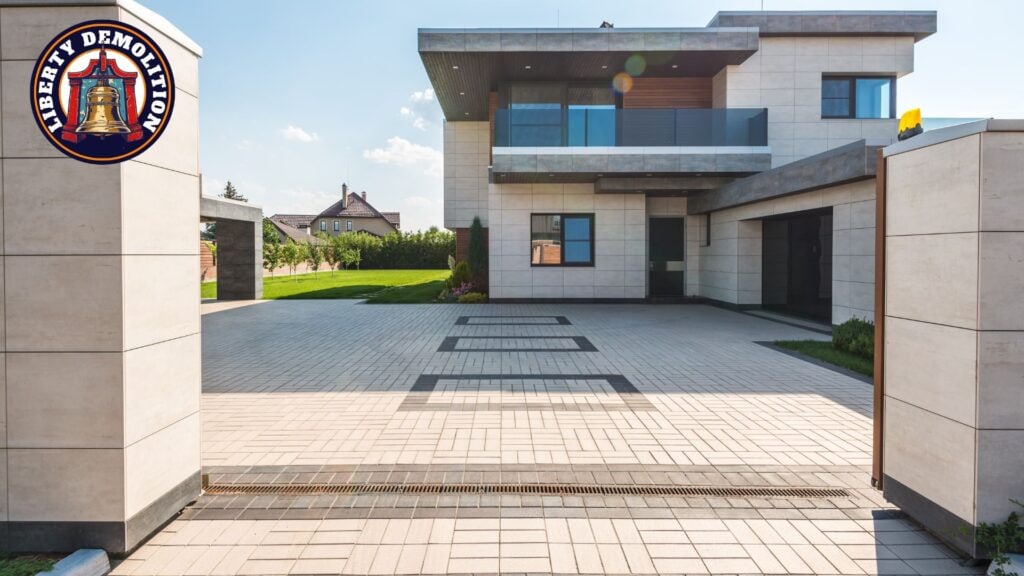
Exterior Finishes
The exterior of a house is the first line of defense against external elements and plays a crucial role in insulation, protection, and energy efficiency. Choices for cladding and siding range from brick, vinyl, wood, stucco, and more. Each comes with its own set of aesthetics, durability, maintenance needs, and costs. Homeowners decide based on the local climate, preferences, and design specifications.
Windows and doors are important for insulation, security, and aesthetic appeal. The costs for these features vary based on materials (like vinyl, wood, or aluminum), energy efficiency ratings, and design.
Additional exterior features, such as decks, porches, gutters, downspouts, and landscaping can further enhance a home’s aesthetic and functional appeal. Depending on materials and designs, these additions can influence the overall budget significantly.

Interior Finishes
The interior of the house is where style meets functionality. Here are the components you need to decide on when it comes to this factor:
- Walls and Ceilings. Options like paint, wallpaper, or specialized finishes can change the room’s feel. Costs can change based on the quality of materials, complexity of application, and labor rates.
- Flooring. Whether opting for hardwood, carpet, tiles, or laminate, flooring choices influence not just cost but also maintenance, durability, and comfort.
- Cabinetry and Countertops. Important to spaces like kitchens and bathrooms, the materials (granite, laminate, quartz, wood), design, and craftsmanship influence the cost.
- Additional Interior Features. Features like fireplaces, molding, built-in shelves, or specialized lighting can elevate the interior’s appeal. These come with their own set of costs, determined by design complexity, materials, and installation specifics.
Systems (Plumbing, Electrical, HVAC)
These systems are fundamental to comfort, safety, and modern living. Plumbing involves installing pipes, fixtures, and systems for water supply and sanitation. The cost can be influenced by the house’s size, fixture quality, and any specialty systems like water purification or radiant floor heating.
For the electrical components, setting up wiring, outlets, switches, and following safety protocols can vary in cost depending on the home’s size, local codes, and any advanced systems or automation incorporated.
Meanwhile, HVAC (Heating, Ventilation, and Air Conditioning is important for regulating the home’s temperature and ensuring air quality. The choice between systems (like central, split, or radiant), their energy efficiency, and installation intricacies influence the cost.
Permits and Fees
Beyond the direct construction costs, homeowners should also account for the expenses related to permits, inspections, and other regulatory requirements. These can vary depending on local building codes and regulations.
Building Permits
Before starting with the rebuilding process, most municipalities require a building permit. This permit verifies that the planned construction meets local codes and zoning regulations. The cost of this permit can vary based on the scope of the project, property location, and local government fees.
Specialized Permits
Depending on the nature and location of the rebuild, additional permits may be required. This can range from environmental clearances if building near protected areas, to permits for specialized installations like pools, decks, or basements.
Inspection Fees
During and post-construction, periodic inspections might be mandated to ensure the work aligns with the permit stipulations and local building codes. While some of these inspections might be covered under the building permit cost, others could attract separate fees.
Impact Fees
Some municipalities demand impact fees on new construction or major renovations. These fees are intended to offset the potential impact on local infrastructure, such as roads, schools, and public utilities.
Contingency Fund
A contingency fund acts as a financial cushion to see to it that unexpected costs don’t halt the project or compromise its quality. By allocating a certain percentage (often recommended between 10%-20%) of the total estimated cost towards contingencies, homeowners can tackle unforeseen expenses without derailing their financial plans.
This fund can address a range of unexpected costs. It might be discovering an old, faulty plumbing system that needs replacement, unanticipated soil conditions requiring foundation modifications, or even changes in design preferences mid-project.
Beyond the tangible benefits, a contingency fund offers homeowners peace of mind. Knowing there’s a safety net in place allows for a smoother, less stressful rebuilding process.

Hidden Costs to Consider
While budgeting for obvious expenses is a given when rebuilding a house, there are often overlooked or unexpected costs that can catch homeowners off guard. Recognizing and planning for these potential financial pitfalls is crucial to ensure a smooth and stress-free construction experience.
Unforeseen Structural Issues
While a home may look sound from the outside, hidden issues can lurk beneath the surface:
Foundation Repairs
Settling foundations or unnoticed cracks can jeopardize the entire structure. Addressing these issues might require additional excavation, reinforcement, or even underpinning – all adding to the cost.
Aging Infrastructure
Old homes might house archaic plumbing, heating, or electrical systems. Upgrading these to modern standards is not just about convenience but safety too.
Water Damage
Prolonged exposure to moisture can lead to mold, rot, or structural weakening. Identifying and rectifying these problems early on can save on more extensive repairs down the line.
Hazardous Materials Removal
Older homes, in particular, can sometimes house hazardous materials, like asbestos or lead-based paint. Safe removal and disposal of these materials are crucial for health and are also legally mandated.
- Asbestos. Commonly used in insulation, flooring, and roofing in older homes, asbestos poses significant health risks. Professional removal, which can be costly, is essential to prevent dangerous exposure.
- Lead Paint. Homes built before 1978 might have lead-based paint. Before any renovation or demolition, it’s crucial to test and, if present, remove it safely.
The costs don’t just end at removal. Proper disposal of hazardous waste, in line with environmental guidelines, can add to expenses.
Upgrades and Customizations
While not always “hidden”, the desire or need for upgrades and customizations can quickly escalate the rebuilding budget.
Material Upgrades
Opting for high-end materials or finishes can dramatically elevate costs. From granite countertops to hardwood floors, these choices, while enhancing aesthetics and longevity, come with a price.
Technological Additions
Smart home features, energy-efficient installations, or home theaters can enhance living experiences but need significant cost.
Design Tweaks
Changing design elements mid-project, whether due to preference or necessity, can strain budgets.
Landscaping and Outdoor Spaces
The focus on the house structure might overshadow the importance of outdoor spaces. Yet, landscaping, gardens, patios, and other exterior features play a vital role in the overall aesthetic and functionality of a property.
- Gardens and Lawns. From soil preparation, plants, trees, to irrigation systems, establishing gardens can be a considerable cost.
- Outdoor Features. Building patios, decks, pools, or outdoor kitchens not only require materials and labor but also potential permits and inspections.

Tips for Cost Reduction
When considering a project as significant as rebuilding a house, homeowners need to strike a balance between their vision for the perfect home and the practical realities of their finances. Here are some important tips for reducing costs:
1. Prioritizing Needs vs. Wants
Start by listing out the non-negotiable aspects of your rebuilding project—this could include fundamental repairs, structural necessities, or any mandatory upgrades to comply with building regulations. After accounting for your needs, allocate a separate budget for ‘wants’. These are features or elements you’d like to have but can forgo if budget constraints tighten. This might include luxury fixtures, high-end appliances, or aesthetic enhancements.
2. DIY vs Professional Services
One of the significant debates homeowners face is deciding between doing tasks themselves and hiring professionals. Both options have their pros and cons:
DIY Advantages
- Taking on certain tasks, especially cosmetic ones like painting or landscaping can save a considerable amount.
- DIY allows homeowners to infuse personal touches and customize aspects of their homes according to their preferences.
DIY Disadvantages
- DIY projects often take longer, especially for novices.
- Without professional experience, there’s a higher likelihood of errors, which can end up being costlier in the long run if repairs are needed.
Professional Services Advantages
- Professionals bring expertise and can complete tasks more efficiently and to a higher standard.
- Many professional services offer guarantees or warranties on their work, providing peace of mind.
Professional Services Disadvantages
- While you pay for their expertise, the upfront cost for professionals can be significantly higher than DIY.
Material and Fixture Selection
Before making any purchases, do thorough research. Compare different materials in terms of durability, maintenance, and price. Sometimes, less expensive alternatives can provide a similar look and feel without compromising much on quality. If possible, buy materials in bulk. Suppliers often offer discounts for larger quantities. It’s also crucial to keep an eye out for sales, especially during holiday seasons or end-of-season clearances. This can be particularly beneficial for fixtures and appliances.
Negotiating with Contractors
Negotiation is an art, and when done right, it can lead to substantial savings. Always approach several contractors to get quotes. This will give you a clearer picture of the market rate and provide leverage during negotiations. Be upfront about your budget constraints. A trustworthy contractor will often provide suggestions or alternatives to fit within your budget. Sometimes, instead of a direct discount, contractors might be willing to offer additional services at no extra cost, such as minor repairs or maintenance checks.
Make Your Next Move in Home Rebuilding an Informed One!
While there are many considerations in rebuilding a house, understanding each aspect ensures homeowners can make informed decisions. This is to ensure that their houses and finances are safe.
If you’re considering a home demolition or rebuild, there’s no better partner than a dedicated team of professional demolition contractors with a proven track record. At Liberty Demolition, we don’t just offer demolition services; we provide a commitment. Our comprehensive services, spanning residential to industrial demolitions, are executed with dedication to safety, environmental responsibility, and utmost customer satisfaction.
So, as you think about your next steps in home rebuilding, remember – with Liberty Demolition, you’re choosing more than just a service; you’re opting for a partner in progress. Trust us to lay the right foundation for your future home. Call us today for a free quote.
